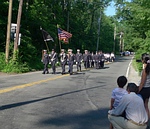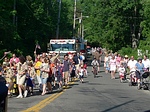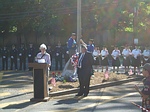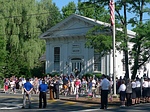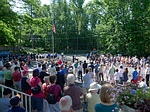Memorial Day 2010
On Monday, May 31, Palisadians gathered at the flagpole on Closter Road and Route 9W to remember the young soldiers who gave their lives to protect this country. The event was celebrated by a parade, and with speeches by Murray Cohen and by Alice Gerard, chair of the Palisades HIstoric Committee. Alice Gerard's speech is reproduced below.
"We meet here today to remember the brave young men who gave their lives to defend our country. Often when we gather here we think of the veterans of recent wars, those who fought in far-away lands. But I am a historian, with a longer perspective. I would like to talk today about four men from Palisades who fought in long-ago wars: Jonathan Lawrence Junior, who served in the Revolutionary War; John Marder Perry, a casualty of World War I, and Ken Larsen and Alexander Drab, who died at sea during World War II.
Jonathan Lawrence Jr. was born in 1759. His father, Jonathan Lawrence Sr., was a businessman in New York City. His grandfather, Jonathan Lawrence the Elder Senior, lived in the Big House here in Palisades. In 1775 Jonathan’s father was appointed one of three Commissioners to help build a new fort on the Hudson, Fort Constitution. Jonathan Jr. and his parents were at Fort Constitution in May 1776, when his mother was accused of selling tea at black market prices. Jonathan left his parents, possibly because he disapproved of what his mother had done, and by summer was living here with his grandfather and helping to guard the Hudson, which was threatened by British warships coming up from New York. He was back at Fort Constitution in December, serving as a clerk although he was just seventeen.
In March, 1777, Jonathan enlisted in Colonel Malcom's regiment as a Second Lieutenant. He spent two months at Valley Forge with the Continental Army and fought in the Battle of Monmouth on his way north. During the summer of 1778 he was promoted to First Lieutenant and was acting as Assistant Adjutant General to the regiment at Fort Clinton, overlooking the Hudson at Bear Mountain, although he was only 19.
In the spring of 1779 Malcom's regiment was merged with another and Jonathan Lawrence lost his army position. He went home to the Big House, now owned by his Uncle Nathaniel, (his grandfather had died in 1777) and was soon appointed a Captain in the militia, troops made up of local men who signed on for six months at a time and were under the command of Colonel Ann Hawkes Hay.
One of Jonathan’s duties was to gather information about enemy troops, which was then passed on to George Washington. Washington mentioned him several times in dispatches during the spring of 1781, calling him sensible and discreet. On July 21, 1780, Captain Jonathan Lawrence captured a famous British spy named James Moody, near Englewood, NJ.
On June 19, 1781, Washington issued an order appointing Jonathan Lawrence, Esq., to the rank of Captain in the Corps of Sappers and Miners. It was these same Sappers and Miners who built a blockhouse here, the remains of which could still be seen on Woods Road until recently, to oversee the Hudson and defend the inland areas from invasion by the British. Lawrence's service in the Corps was short. On August 28, 1782, he wrote asking permission to leave the army for reasons of health. He had contracted tuberculosis during his military service, and was forced to resign his commission.
Jonathan Lawrence went back to the Big House to recover, if possible, and to resume a normal life. He married twice, had six children, and with his veteran’s benefit succeeded in 1794 in buying back the Big House, which his uncle had sold out of the family. In 1802 Jonathan Lawrence Junior died, at the age of forty-two, probably of tuberculosis, the disease with which he had struggled for so many years. His tombstone is in the Palisades Cemetery. Although Jonathan Lawrence did not die while in military service, he was truly a casualty of the war.
At the end of an article that my mother Alice Haagensen wrote about him, she said, “This gallant young man, admired and respected by all his officers, from Washington down, has been forgotten in this village that meant so much to him.”
In 1861 Jonathan Lawrence’s son Herbert gave the land – this land — for a Palisades flagpole, which was erected in May, 1861 a few weeks after Fort Sumter. Because the pole was topped by a large Liberty cap, symbolizing this community’s opposition to slavery, for many years it was called “The Liberty Pole”. Twenty men from Palisades served in the Civil War, including Jonathan’s grandson George Lawrence and two Garrison boys, but all of them came home.
The memorial plaque at the base of this flagpole – the fourth flagpole on this spot — commemorates 14 of the 18 men and women from Palisades who served in World War I. (two men in the Merchant Marine and the two women who served overseas in the Motor Corps were not counted.)
Seventeen of them came home but one did not. John Marder Perry, son of a prominent local lawyer who lived where the Esplanade now is located, left home to enlist when he was underage. He joined the Old 69th, which was remembered as the 165th N.Y. of the Rainbow Division. John Perry was on General Pershing’s staff and believed by his family to be safe. He was in a training camp near Brest but was then sent to temporary trenches near Bar‑le‑Duc. After that he was transferred to front-line forces for a counterattack during which he received a fatal shrapnel wound. He was taken to a house at Chateau Thierry and then to a hospital where he died on July 28, 1918 at the age of 19. His grieving parents gave the land for the American Legion Post on Route 340 in his memory.
Fifty-four Palisadians served in World War II. They included one woman, Margaret Greenfield, one Doyle, two Garrisons, three Aubreys, four Emerizys, and five members of the Drab family, immigrants from Hungary who came here in the 1930s and had a farm off Route 9W. Bill Knudson, who also served in the war, remembers, “My friend Ken Larsen was an AB seaman on a standard oil tanker, the SS Stanvac Calcutta. Shortly after hostilities broke out, on June 6 1942, they were overtaken by a German raider, the Stier…Thirteen American crewmen, including Ken Larsen, were killed in the fighting. As far as I know Ken Larsen was the first boy from Palisades killed by enemy action during World War II
Alexander Drab was the other enlistee who did not return. Bill Knudson wrote about Alex, who was a friend of his: “In the summer we went crabbing and in the winter we went hunting. Alex enlisted in the army in 1939 and worked his way up to Staff Sergeant. During the war in the Pacific he was wounded and transferred to a hospital ship where he died on August 17, 1943 and was buried at sea. He was awarded the Purple Heart and Bronze Star medals.”
And the tradition continues today. Cadet Christopher Y. Choi, son of Charles and Young Ji Choi of Palisades, NY, graduated from the U.S. Military Academy on May 22. He was commissioned as a second lieutenant in the U.S. Army within the Field Artillery branch and will report to Fort Carson, CO., for his first assignment. His awards include the National Defense Service Medal, Basic Parachutist Badge, and German Armed Forces Proficiency Badge
Throughout the history of this community, its sons — and recently some of its daughters — have been willing to give their lives to preserve our country. We thank them all."


